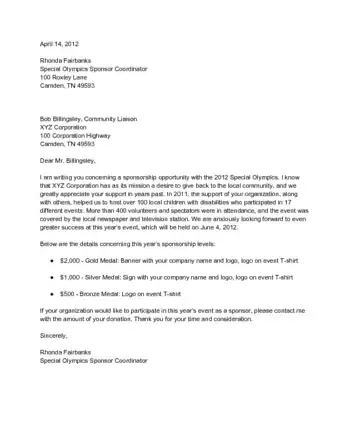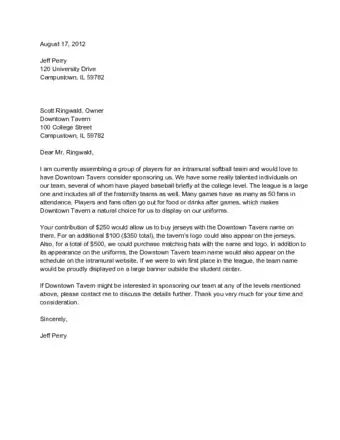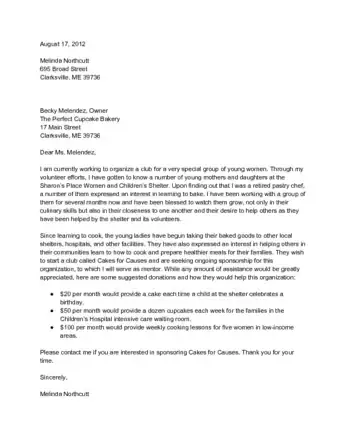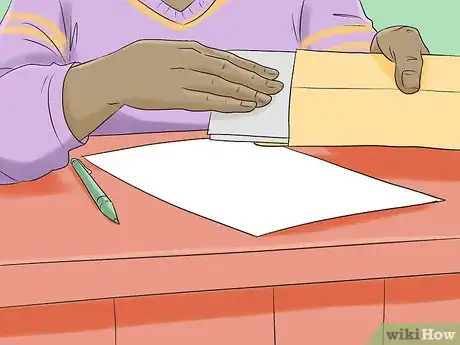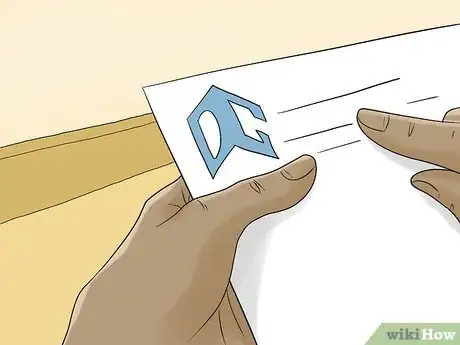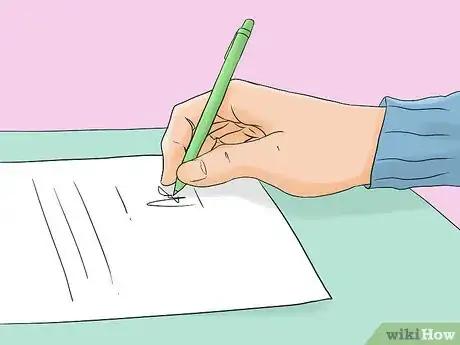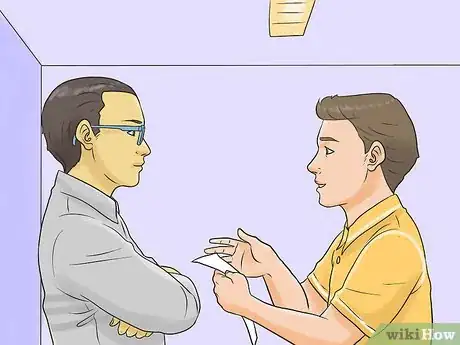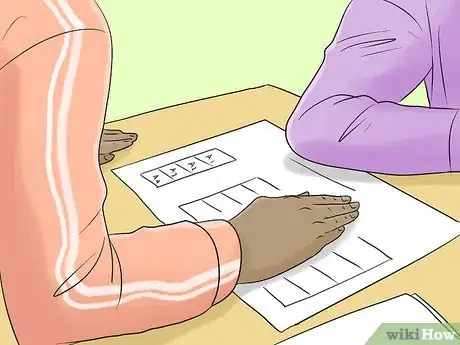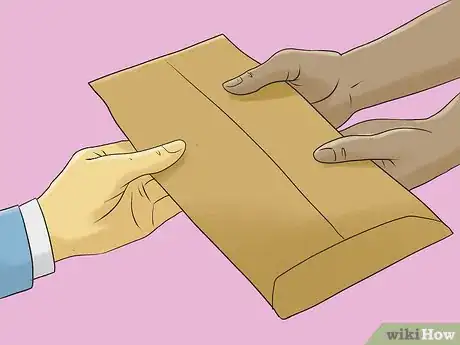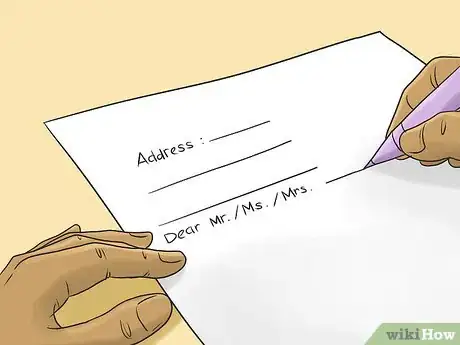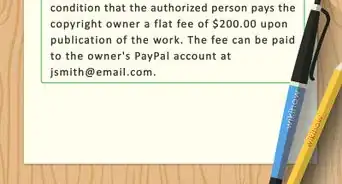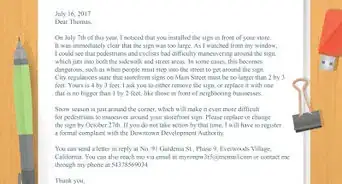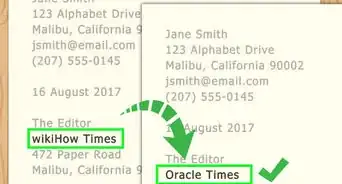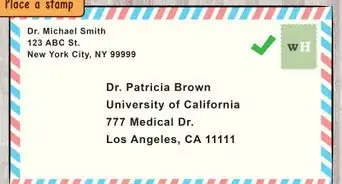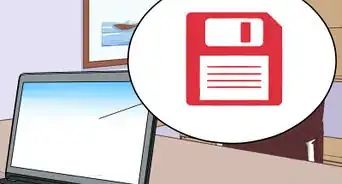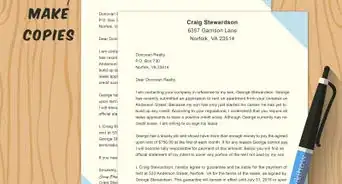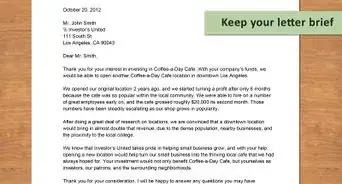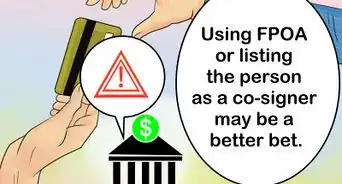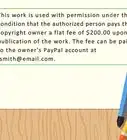This article was co-authored by Ernest Sturm. Ernest Sturm is a Marketing Expert and the Owner of Runway Influence and Runway Waiters, as well as the President of Runway Collective. With over 10 years of experience as an entrepreneur, he specializes in producing social media campaigns and social brand activations. Runway Influence has a 5-star rating and partners with luxury brands and top influencers.
wikiHow marks an article as reader-approved once it receives enough positive feedback. This article has 69 testimonials from our readers, earning it our reader-approved status.
This article has been viewed 6,505,621 times.
If you're hoping to get someone to sponsor your event or something else you're doing, you should write a sponsorship letter. Your letter must convince the sponsor that it's worth contributing and clearly outline the benefits the sponsor gets, presenting an executive summary that details your event or mission. Writing a proper sponsorship letter can make all of the difference between securing the sponsorship or being ignored.
Things You Should Know
- Research the exact kind of sponsorship you're seeking. Reflect on what skills and experience you can offer a business.
- Write your letter in formal business format. Read through sample sponsorship letters to get an idea of the gold standard.
- Be sure to include details on what the business can earn from offering you sponsorship and proofread before you wrap things up.
- Your pitch should always be tailored to the specific sponsor you're meeting, depending on their size and probable budget.
Steps
Preparing to ask for Sponsorship
-
1Determine your goals. What are you hoping to achieve with the sponsorship letter – specifically? What do you want the business to do? What are you using the sponsorship for and why does it matter? Before you write a sponsorship letter, you should know the answers to these questions.
- Sponsorship letters should be specific and focused. If they are too vague or you don't know what you're seeking or why, they won't be very effective.
- Understand why you want to meet the goals. Sponsorship requests are more successful if they are accompanied with a sense of purpose or passion. Convince people why it's worth giving time or money to this cause, perhaps by telling them a story about how the cause has helped someone or the community [1]
-
2Make a list of businesses. Who might have a motivation to support your cause? Maybe there's a business owner who has a personal reason to support your goals. Or maybe there's a non-profit that's supported similar missions. Who has given to similar events? You need to research the field.
- Make sure to include businesses or people on the list with whom you or others who work with you have a personal connection. Never underestimate the value of personal connections. [2]
- Don't overlook small businesses or those that don't have storefronts. They might be willing to give, too. Remember that you can play up the "local" angle. Hometown businesses often see an advantage in remaining connected to their communities.
- If you are working on a team, divvy up the businesses on the list and give each team member the task of contacting some of them, so each gets personal outreach.
Advertisement -
3Determine what you're seeking. Sponsorship can take many different forms. Before you write a sponsorship letter, you need to determine what you're asking for.
- Cash or in-kind donations are both possibilities. In-kind donations mean the business donates materials or products that can be used at the event instead of just giving money. Sometimes these take the form of services not tangible goods.
- Perhaps you are willing to take volunteer work instead of a product. Either way, you need to be very clear in what you're seeking - specifically.
-
4Determine what you're offering. Often sponsorship letters will allow people to choose from different sponsorship levels. This allows businesses to give when they don't have as much expendable income as larger firms.
- Decide sponsorship levels. You should clearly outline the different benefits achieved by different levels of sponsorship. People who give more should get more.
- An advertising banner, a public announcement about the company or sponsorship, and the company's logo appearing on a website or in promotional materials or programs are all examples of benefits you could offer.
-
5Determine the name of the specific person who should get the letter. Don't ever address the cover letter to the generic “to whom it may concern.” That seems too impersonal.
- Often, the proper person will be the person who runs the company's Human Resources Department or its CEO. You should call the company or look on its website and determine who handles sponsorships. Don't guess at this. To be effective, the sponsorship letter absolutely must be addressed to the right person. Get the spelling of their name and their title right.
- You should also figure out if the organization has a charitable giving policy so you don't waste your time and can align your request with the policy. [3]
Understanding the format
-
1Study sample sponsorship request letters. You can find many templates for sponsorship request letters on the Internet. Some are paid services, but many are free. You should read these letters to get a sense of the format and content.
- Don't copy a sample letter too closely, though. You need to tailor your letter to the organization you're writing to so it sounds personal and not too formulaic. [4]
- For example, if you know a CEO has a personal background that relates to your cause, you can personalize the letter to that person. You should know the background of the people or companies you're soliciting, and you should tailor the letters so they feel personal.
-
2Choose the proper tone. Tone will depend on audience. However, you should always be professional and not too colloquial in a sponsorship letter.
- Put the letter on formal letterhead that has the logo and name of your organization. This will make your request look more professional. If you're asking for a sponsorship for yourself, you could still create professional letterhead that has your name at the top in a nice font.
- If you're writing to a business or other organization, more formal is best. If you're writing to a family member or friend, you could be less formal, but you still shouldn't be so casual you sound disrespectful. Whipping off an informal email is unlikely to get good results in either case.
-
3Use standard business letter format. A typical sponsorship letter uses the format seen in many business letters. You should use the right structure or it won't look professional.
- Start the letter with the date, and then the sponsor's name and address.
- Then, after a space, put the salutation: Dear (Name of the person) and a comma.
- Keep it short. Keep the sponsorship letter on one page. People are unlikely to have time to read more. Most people being solicited will give about a minute to your sponsorship letter. So in addition to keeping it on one page, make sure the language is concise and clear. [5]
- Send it snail mail. Email requests make it seem like you didn't take much care when sending it.
-
4End with gratitude. At the end of the sponsorship letter, you should thank them for their consideration. Be sure to add breaks between paragraphs and leave a space for your hand-written signature.
- End with a respectful, professional salutation, such as: Respectfully, and then your name and title. Sign it personally.
- Include other materials. You might want to provide a printed flyer with your sponsorship letter to provide background on your event or company. This will provide additional credibility and may make the business feel more comfortable in supporting you.
- Similarly, if your organization has received news coverage, you could include a sample news article to back up what you've done.
Perfecting the Content
-
1Write a good intro. In the opening paragraph of the letter, you should immediately introduce yourself or your company and your cause – specifically. Don't beat around the bush. People need to be hooked right out of the gate.
- Don't assume people know who you are or what your organization does. Explain those things, clearly. Begin with a description of the company (if it's a corporate letter) or yourself (if it's for personal sponsorship). For example, such-and-such firm is a nonprofit organization committed to rehabilitation... etc.
- Highlighting a few accomplishments right away will make it clear why it's not a risk to give you sponsorship. Make it very clear how the money will be specifically used.
- In the second paragraph or first, you need to make the direct request for sponsorship and explain why you are seeking it.
-
2Outline the benefits. In order to give you sponsorship, a company or person needs to be convinced they will benefit from doing so. So in the middle paragraphs of the letter, clearly communicate the benefits – not to you, but to them.
- If the sponsors will get good publicity out of the sponsorship, for example, explain how. Be very specific: Will the event be televised? How many people will be attending? Will there be VIPS? If other prominent companies or their competitors are sponsoring your event, you might want to mention that.
- Give the sponsors options. They will like the fact they have different choices to match their individual needs or budgets.
-
3Convince with supporting evidence. This means including a few numbers – audience size, for example, or demographics of those they will reach.
- Also don't forget to thread in an element of emotional appeal - a personal story of someone who will be helped, for example, if said briefly (in a sentence or two) can be very moving.
- Explain how you will give the sponsors recognition for their sponsorship. Perhaps they can have free booth space at your event in exchange for sponsorship. [6]
- Provide the essential details of the sponsorship deal that they will need to make their decision. Don't forget to include contact information. You might want to also include a self-addressed, stamped envelope to make it easier for them to respond. Don't forget to include the date you need a response by.
- Ask the sponsors how they prefer to be recognized. For example, how do they want their name to appear and do they want to be recognized? Offer possibilities but never assume. Ask.
-
4Communicate background about the event. You should provide some concrete details in the letter to back up your organization or event.
- For example, if you're writing a letter for a charity, you should explain the background of the charity, such as when it was founded, who runs it, who it serves, and any awards or accomplishments it's received.
- Show don't tell. Don't just tell us the group or event are good or worthy. Convince us through showing details – evidence that backs up why or how the event or group are good or worthy. Evidence is more persuasive than superlatives, generally.
-
5Follow up personally. Just sending off a letter to a company is not the most personal way to develop a connection. Although a sponsorship letter is a good idea, follow up in a more personal manner.
- You could call or stop by if you don't get a response in 10 days. Remember though that many CEOS especially will be very busy and could be annoyed. So you might want to schedule an appointment or call first.
- Make sure that you convey excitement about your project. Avoid anything negative. You don't want to sound like you're begging or trying to put a guilt trip on them about donating..
- If the answer is “maybe,” don't feel bad about following up. Just don't do it immediately or too much or you might become annoying.
- Never be presumptuous. Don't assume they will give you a meeting or sponsorship. Simply thank them for their consideration.
- Don't forget to send a thank you note if you get a sponsorship.
-
6Proofread. You can sabotage your chances for sponsorship if you don't proofread your letter. Letters riddled with spelling or grammar errors don't seem professional. And why would someone want their name attached to an unprofessional event?
- Check punctuation. Many people don't know how to use commas or apostrophes properly. The little things matter here.
- Print out a copy of your letter, set it down, and read the hard copy in a few hours. Sometimes the eye gets so wedded to online content that it can be easier to miss typos if you're reading it online.
- Make sure you send it with proper postage in a professional business looking envelope.
-
7Here is an example:Your Letterhead (if applicable)Date:____Address: _________
_________________
_________________
Dear Mr. / Ms. / Mrs. _______
Recently, I was invited to compete in Miss USA State Preliminary Competition. While at the State Preliminary Pageant, I will have the opportunity to be chosen as the state's representative to the Miss USA National Pageants.
I would be grateful if you helped in sponsoring me in Miss Colorado USA for my chance to win. More than 20-50 women will be competing with me. This event will be televised regionally with an anticipated audience of 2 to 300,000 and all my sponsors will be named in the pageant and on future productions website.
The amount a sponsor may contribute is flexible. You could assist me through one of the options listed below.
$____ – Your name, description, and logo
$____ – Your name and description
$____ – Your name and logo
$____ – Your name
If you are interested in sponsoring me, please get back to me at ___________________.
Thank you very much for your time.
Sincerely,
Signed Name
Typed Name
Community Q&A
-
QuestionIs there a maximum number of sponsorship options that should be included within the letter?
 Community AnswerDon't add too many, or you might make yourself look desperate and like you'd do anything, which isn't very professional or promising for a potential sponsor. A smaller number is always better than having 15 different options to choose from. You also have to think about how busy the people you are writing to are, they simply won't be able to spend a lot of time on your letter.
Community AnswerDon't add too many, or you might make yourself look desperate and like you'd do anything, which isn't very professional or promising for a potential sponsor. A smaller number is always better than having 15 different options to choose from. You also have to think about how busy the people you are writing to are, they simply won't be able to spend a lot of time on your letter. -
QuestionDo I need to write the address on my letter if I am going to hand it directly to the manager?
 Community AnswerIn real terms that might seem overkill. But, in this situation you want to see professional, so it is recommended.
Community AnswerIn real terms that might seem overkill. But, in this situation you want to see professional, so it is recommended. -
QuestionHow do I find a sponsor?
 Community AnswerYou should take some time to research companies available for sponsorship. It would be good if you start off locally.
Community AnswerYou should take some time to research companies available for sponsorship. It would be good if you start off locally.
References
- ↑ http://www.the-fund-raiser.com/event-sponsorship-letter/
- ↑ http://4h.ucanr.edu/files/131483.pdf
- ↑ http://www.sparktemplates.com/events/sponsorship/sponsorship-proposal-letter-sample
- ↑ http://www.letters.org/donation-letter/sample-sponsorship-request-letter.html
- ↑ http://www.the-fund-raiser.com/event-sponsorship-letter/
- ↑ http://www.entrepreneur.com/formnet/form/1037
About This Article
To write a letter to a potential sponsor, address it to the CEO or head of HR. Introduce yourself and explain your company and cause in the first paragraph, then state clearly that you’re looking for sponsors. Outline benefits that would come with their sponsorship, such as advertising or networking opportunities at an event. Include a few facts to appeal to their logic, such as the size of the audience they’ll reach. Thank them at the end and proofread, then sign it by hand and mail. To learn how to choose a tone for your letter or how to outline your points, continue reading the article!
